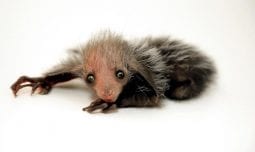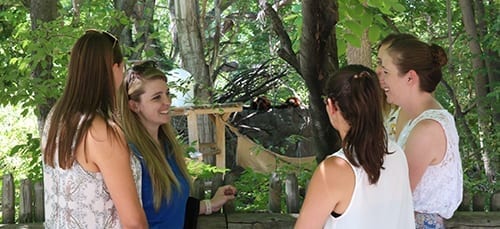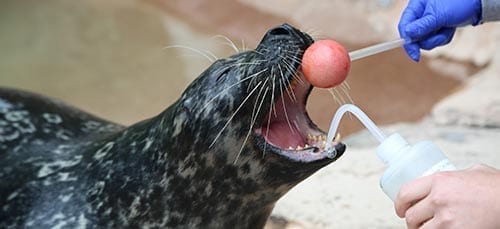Classification
Class Mammalia
Order Primates
Family Daubentoniidae
Genus Daubentonia
Species madagascariensis
Habitat & Range
A wide variety of forest types including rainforest, deciduous forest, dry scrub forest and mangrove forest. While once widely distributed in this variety of forest habitat, currently this species is found primarily in rainforests along the east coast of Madagascar as well as the deciduous forests of the west.
Native (endemic) to the island of Madagascar.

Aye-Aye
Daubentonia madagascariensis
Aye-ayes are nocturnal spending up to 80% of the nighttime hours foraging for food. Adaptations for nocturnal life include dark fur that helps camouflage them in the dense forest and large ears that help them listen for the movement of grubs and larvae. They also have large eyes with a tapetum lucidum – a reflective layer on the back of the eye that improves night vision. Daylight finds aye-ayes high in the trees safely tucked into ball-like nests consisting of interwoven twigs and leaves.
Adaptations
Echolocating Dinner
Aye-ayes are referred to as “percussion foragers” because they use their middle finger to tap on wood, listening for the movement of larvae hidden inside. If they hear movement, they use their rodent-like incisors to gnaw into the bark exposing the larvae and then insert their elongated middle finger to extract the larvae. They are the only primates thought to use echolocation to find prey.
Gnawing Incisors
Aye-ayes were originally classified as rodents because of their continuously growing incisor teeth. They use their incisors to gnaw through bark to expose insect larvae and grubs. Their incisors also are used to pry open the hard shells of coconuts or hard fruits and nuts. They then use their unique middle finger to scoop out the pulp or nutmeats.
Creatures of the Night
Aye-ayes are nocturnal spending up to 80% of the nighttime hours foraging for food. Adaptations for nocturnal life include dark fur that helps camouflage them in the dense forest and large ears that help them listen for the movement of grubs and larvae. They also have large eyes with a tapetum lucidum – a reflective layer on the back of the eye that improves night vision. Daylight finds aye-ayes high in the trees safely tucked into ball-like nests consisting of interwoven twigs and leaves.
Physical Description
- Aye-ayes are 12-16 inches (30-40 cm) long.
- They have a bushy tail 18-22 inches (45-55 cm) long.
- They weigh 5-6 pounds (2.3-2.7 kg).
- Aye-ayes have coarse, shaggy black fur with a mantle of long white-tipped guard hairs.
- They have a round head, large triangular ears, yellow-orange eyes and a pink nose.
- They have long digits with long curved claws except for the big toes.
- Aye-ayes have a distinctive elongated middle digit with a longer claw.
- They have continuously growing incisor teeth.
Diet
What Does It Eat?
In the wild: Wood-boring grubs, fruits, nuts, nectar, seeds and fungi.
At the zoo: Folivore chow flavored with fruit, honey or peanut butter and a variety of fruits and vegetables, nuts, mealworms, sugarcane and tamarind.
What Eats It?
Fossa.
Social Organization
Aye-ayes are generally solitary except for mating pairs and females with offspring. They may tolerate others foraging nearby but females often demonstrate aggression toward other females. Both males and females establish and scent mark territories.
Life Cycle
Both males and females reach sexual maturity at about 2-1/2 years of age. Females are only receptive to mating every 2-3 years due to extensive parental investment. Females advertise their receptivity with loud vocalizations to attract nearby males and will mate with several males during the estrus period. Aye-ayes mate for up to two and a half hours hanging upside down from a branch. A single offspring is born after a gestation period of 157-172 days, and births may occur throughout the year. Newborn aye-ayes are underdeveloped, weigh 3.2-5 oz (90-140 g) and spend their first two months protected in the security of the tree nest. Only the female cares for the infant. Young are weaned at about seven months but stay with the mother for up to two years before going off on their own. Lifespan in the wild is unknown but aye-ayes have lived 23 years in captivity.
Fun Facts
- Because of its strange appearance, it is considered one of the most distinctive mammals on earth.
- The aye-aye is the largest nocturnal primate.
- Aye-ayes fill the ecological niche of woodpeckers which are absent from Madagascar.
- When moving on the ground, aye-ayes raise their clawed fingers so they don’t damage their delicate fingers. This results in a strange, clumsy gait.
- The name “aye-aye” may be derived from the “hai-hai” vocalization they make when fleeing from danger.
- Aye-ayes were originally classified as rodents because of their continuously growing incisors.
Conservation Status
IUCN Status: Near threatened
Once thought extinct, aye-ayes were rediscovered in 1957. Although small populations have been found in several locations on Madagascar, they are very endangered due to loss of habitat. Forests on Madagascar are being cleared for sugar cane and coconut plantations as well as the logging industry. Due to loss of their usual habitat, aye-ayes sometimes raid crops and may be killed by farmers. Some Malagasy natives consider the aye-aye an evil omen and often kill them on sight. Currently aye-ayes are found in 16 protected areas on Madagascar and there are efforts to breed these unique animals in captivity.

Download the App!
Get the FREE Denver Zoo app today, and be a pro the next time you visit the Zoo. You’ll get access to the Zoo map, daily activities and schedules, animal facts, and more. You can even load your membership card onto the app for additional convenience. It puts everything you need for an amazing Zoo experience right into the palm of your hand!






